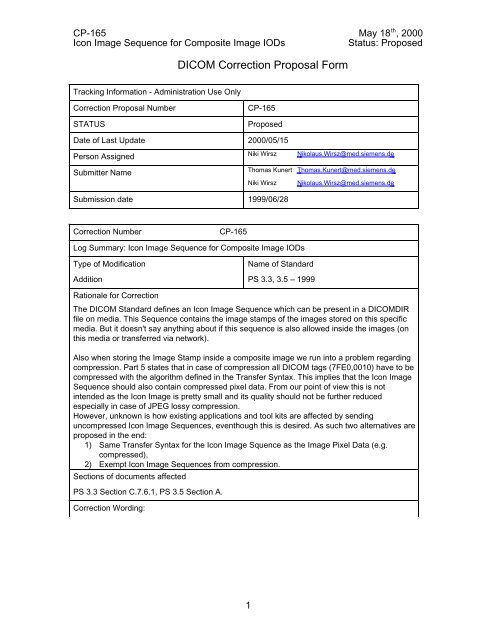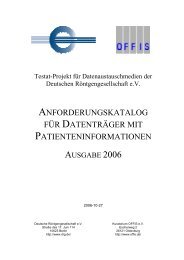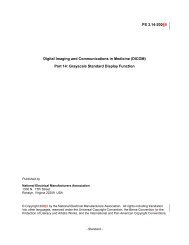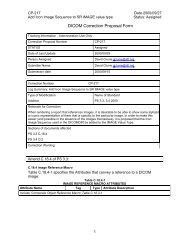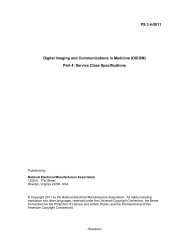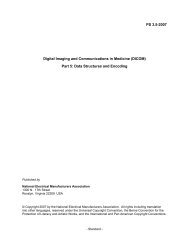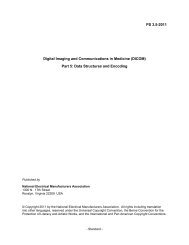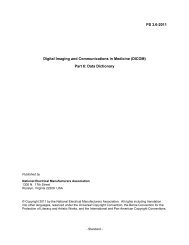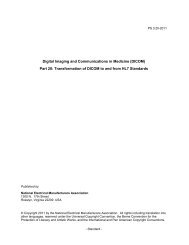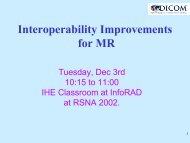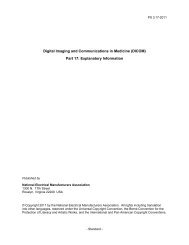DICOM Correction Proposal Form
DICOM Correction Proposal Form
DICOM Correction Proposal Form
Create successful ePaper yourself
Turn your PDF publications into a flip-book with our unique Google optimized e-Paper software.
CP-165 May 18 th , 2000<br />
Icon Image Sequence for Composite Image IODs Status: Proposed<br />
Tracking Information - Administration Use Only<br />
<strong>DICOM</strong> <strong>Correction</strong> <strong>Proposal</strong> <strong>Form</strong><br />
<strong>Correction</strong> <strong>Proposal</strong> Number CP-165<br />
STATUS Proposed<br />
Date of Last Update 2000/05/15<br />
Person Assigned Niki Wirsz<br />
Submitter Name Thomas Kunert<br />
Niki Wirsz<br />
Submission date 1999/06/28<br />
<strong>Correction</strong> Number CP-165<br />
Log Summary: Icon Image Sequence for Composite Image IODs<br />
Type of Modification<br />
Addition<br />
Rationale for <strong>Correction</strong><br />
Name of Standard<br />
PS 3.3, 3.5 – 1999<br />
1<br />
Nikolaus.Wirsz@med.siemens.de<br />
Thomas.Kunert@med.siemens.de<br />
Nikolaus.Wirsz@med.siemens.de<br />
The <strong>DICOM</strong> Standard defines an Icon Image Sequence which can be present in a <strong>DICOM</strong>DIR<br />
file on media. This Sequence contains the image stamps of the images stored on this specific<br />
media. But it doesn't say anything about if this sequence is also allowed inside the images (on<br />
this media or transferred via network).<br />
Also when storing the Image Stamp inside a composite image we run into a problem regarding<br />
compression. Part 5 states that in case of compression all <strong>DICOM</strong> tags (7FE0,0010) have to be<br />
compressed with the algorithm defined in the Transfer Syntax. This implies that the Icon Image<br />
Sequence should also contain compressed pixel data. From our point of view this is not<br />
intended as the Icon Image is pretty small and its quality should not be further reduced<br />
especially in case of JPEG lossy compression.<br />
However, unknown is how existing applications and tool kits are affected by sending<br />
uncompressed Icon Image Sequences, eventhough this is desired. As such two alternatives are<br />
proposed in the end:<br />
1) Same Transfer Syntax for the Icon Image Squence as the Image Pixel Data (e.g.<br />
compressed),<br />
2) Exempt Icon Image Sequences from compression.<br />
Sections of documents affected<br />
PS 3.3 Section C.7.6.1, PS 3.5 Section A.<br />
<strong>Correction</strong> Wording:
CP-165 May 18 th , 2000<br />
Icon Image Sequence for Composite Image IODs Status: Proposed<br />
Amend the following entry in Section C.7.6.1 General Image Module Table C7-7<br />
GENERAL IMAGE MODULE ATTRIBUTES in PS 3.3<br />
Attribute Name Tag Type Attribute Description<br />
Icon Image<br />
Sequence<br />
> Image Pixel<br />
Module should be<br />
macro<br />
(0088,0200) 3 This icon image is representative of the<br />
Image.<br />
2<br />
See C.7.6.1.1.6 for further explanation.<br />
Amend the following sub-section in Section C.7.6.1.1 General Image Attributes<br />
Description in PS 3.3<br />
C.7.6.1.1.6 Icon Image Sequence<br />
An Icon Image may be used as a key representative of an Image. It is<br />
defined as a Sequence which contains a single Item encapsulating the Data<br />
Set made of the Data Elements of the Icon Image. The Data Elements are<br />
defined by the Image Pixel Module (see Section C.7.6.3).<br />
Alternative 1):<br />
Amend the following note in Section A Transfer Syntax Specifictions in PS 3.5.<br />
Note: The Data Element Icon Image Sequence (0088,0200) shall have the<br />
same Transfer Syntax as the image Pixel Data (7FE0,0010).<br />
Alternative 2):<br />
Amend the following exception note in Section A.4 TRANSFER SYNTAXES FOR<br />
ENCAPSULATION OF ENCODED PIXEL DATA in PS 3.5.<br />
Note: Any instance of the Tag (7FE0,0010) that occurs in an Icon Image<br />
Sequence (0088,0200) shall not be compressed.<br />
Alternative 3):<br />
Amend the following exception note in Section A.4 TRANSFER SYNTAXES FOR<br />
ENCAPSULATION OF ENCODED PIXEL DATA in PS 3.5.<br />
A.4 TRANSFER SYNTAXES FOR ENCAPSULATION OF ENCODED PIXEL DATA<br />
These Transfer Syntaxes apply to the encoding of the entire <strong>DICOM</strong> Data Set,<br />
even though the image Pixel Data (7FE0,0010) portion of the <strong>DICOM</strong> Data Set is<br />
the only portion that is encoded by an encapsulated format. This implies that<br />
when a <strong>DICOM</strong> Message is being encoded according to an encapsulation<br />
Transfer Syntax the following requirements shall be met:<br />
a) The Data Elements contained in the Data Set structure shall be encoded with Explicit<br />
VR (with a VR Field) as specified in Section 7.1.2.
CP-165 May 18 th , 2000<br />
Icon Image Sequence for Composite Image IODs Status: Proposed<br />
b) The encoding of the overall Data Set structure (Data Element Tags, Value Length,<br />
etc.) shall be in Little Endian as specified in Section 7.3.<br />
c) The encoding of the Data Elements of the Data Set shall be as follows according to<br />
their Value Representations:<br />
⎯ For all Value Representations defined in this part of the <strong>DICOM</strong> Standard, except for<br />
the Value Representations OB and OW, the encoding shall be in Little Endian as<br />
specified in Section 7.3.<br />
⎯ For the Value Representations OB and OW, the encoding shall meet the following<br />
specification depending on the Data Element Tag:<br />
⎯ Data Element (7FE0,0010) Pixel Data may be encapsulated or native.<br />
It shall be encapsulated if present in the top-level Data Set (i.e. not nested<br />
within a Sequence Data Element).<br />
Note: The distinction between fixed value length (native) and undefined value length<br />
(encapsulated) is present so that the top level data set Pixel Data can be<br />
compressed (and hence encapsulated), but the Pixel Data within an Icon<br />
Image Sequence may or may not be compressed.<br />
If native, it shall have a defined Value Length, and be encoded as follows:<br />
where Bits Allocated (0028,0100) has a value greater than 8 shall have<br />
Value Representation OW and shall be encoded in Little Endian;<br />
where Bits Allocated (0028,0100) has a value less than or equal to 8<br />
shall have the Value Representation OB or OW and shall be encoded in<br />
Little Endian.<br />
Note: That is, as if the transfer syntax were Explicit VR Little Endian .<br />
If encapsulated, it has the Value Representation OB and is a sequence of bytes<br />
resulting from one of the encoding processes. It contains the encoded pixel data<br />
stream fragmented into one or more Item(s). This Pixel Data Stream may<br />
represent a Single or Multi-frame Image. See Tables A.4-1 and A.4-2:<br />
⎯ The Length of the Data Element (7FE0,0010) shall be set to the Value for<br />
Undefined Length (FFFFFFFFH).<br />
⎯ Each Data Stream Fragment encoded according to the specific encoding<br />
process shall be encapsulated as a <strong>DICOM</strong> Item with a specific Data<br />
Element Tag of Value (FFFE,E000). The Item Tag is followed by a 4 byte<br />
Item Length field encoding the explicit number of bytes of the Item.<br />
⎯ All items containing an encoded fragment shall be made of an even number<br />
of bytes greater or equal to two. The last fragment of a frame may be<br />
padded, if necessary, to meet the sequence item format requirements of the<br />
<strong>DICOM</strong> Standard.<br />
Notes:1. Any necessary padding may be added in the JPEG compressed data stream as per ISO 10918-<br />
1 such that the End of Image (EOI) marker ends on an even byte boundary, or may be<br />
appended after the EOI marker, depending on the implementation.<br />
2. ISO 10918-1 defines the ability to add any number of padding bytes FFH before any marker (all<br />
of which also begin with FFH). It is strongly recommended that FFH padding bytes not be added<br />
before the Start of Image (SOI) marker.<br />
⎯ The first Item in the Sequence of Items before the encoded Pixel Data<br />
Stream shall be a Basic Offset Table item. The Basic Offset Table Item<br />
Value, however, is not required to be present:<br />
3
CP-165 May 18 th , 2000<br />
Icon Image Sequence for Composite Image IODs Status: Proposed<br />
⎯ When the Item Value is not present, the Item Length shall be zero<br />
(00000000H) (see Table A.4-1).<br />
⎯ When the Item Value is present, the Basic Offset Table Item Value shall<br />
contain concatenated 32-bit unsigned integer values that are byte<br />
offsets to the first byte of the Item Tag of the first fragment for each<br />
frame in the Sequence of Items. These offsets are measured from the<br />
first byte of the first Item Tag following the Basic Offset Table item (See<br />
Table A.4-2).<br />
Note: For a Multi-Frame Image containing only one frame or a Single Frame Image, the Basic Offset<br />
Table Item Value may be present or not. If present it will contain a single 00000000H value.<br />
⎯ This Sequence of Items is terminated by a Sequence Delimiter Item with the<br />
Tag (FFFE,E0DD) and an Item Length Field of Value (00000000H) (i.e., no<br />
Value Field shall be present).<br />
4


